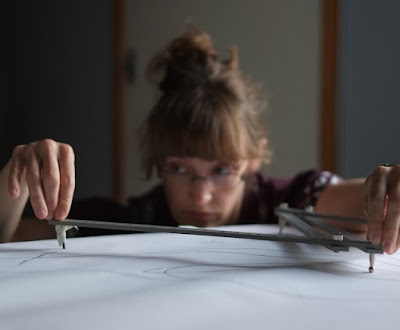It’s a lonely walk from the car park. I'm looking for the archaeologists, somewhere on the park they've been surveying for a few days. The weather is changeable, one minute warm sun and the next heavy dark clouds and driving rain. As I walk along the path the rain turns to hail stones and it's really chilly.
Then I see them in the distance, and it warms me. Not stopping for the weather, the archaeologists plough on through, choreographing their poles and tapes, a step by step measure across the ground, delving rods into the earth.
I sidle up to one of them, a student who is sheltering under a tree and leaning on a red and white striped pole, it seems like a sensible place to be. I ask her what they're doing. She describes marvelous things to me, like tapping the earth’s magnetic pole, gauging amounts of moisture in the soil and what the gaps tell us. She talks of lasers passing through orange prisms and ways of seeing into the earth. She stands by a pile of rods and tripods. I think they are magician's tools.
I speak to Rob. He tells me how they were led here, to this spot, by viewing aerial images and seeing the tell tale shapes of the earth that we can't see standing on the ground. It's like reading the signs meant for the gods, and seeing back in time.
I watch them for a while, mapping this other viewpoint. Mapping and re-mapping, mapping materiality, mapping by metal, stone, wood, soil.
The rain is still throwing it down, forced into us by a strong wind. Their carefully placed tapes come loose and flap, they catch them and re-measure and their rhythmic trudge continues. Finally the sun breaks out again, and dries my jeans.
I see some people I know, Katrien and Mark. I don't speak to them much because they are counting. Katrien draws rectangles and numbers on her clipboard. She mentions some animal bones that have been spotted in a river.
The measuring is done for the day, and they start to pack up and compare notes. Everybody seems tired and glad to finish, but still with a mild excitement because they know that Mark will take the results and look at the images that evening and it will be very soon that they begin to see what the instruments can see.
Richard appears, having fetched the van. I ask him about the river bones. Katrien and I follow him in a near-run across the scrub, me stumbling, Katrien more gracefully. We reach a small brook, Richard navigates its curves and locates the spot. We crouch on the grass, my knees are on sodden soil and my hands lean on stinging nettles. I have to get my chin over the edge of the water to see the bones.
At first I can’t see them, then do, or don’t, or is it rock, I’m not sure. "How did you spot them?" I ask Richard.
"Just walking in the water."
His eyes are trained to see bones, even when camouflaged, it's like a habit. Give Richard an animal bone and he instantly starts to identify it, what age it was, trying to find its story. It's like a reflex action.
Exhausted from battling the weather and the physicality of the repetitive walking, lifting, placing, walking, lifting, placing, staking and taping, the archaeologists climb back in the bus and are gone. There is no sign that they were ever here, but for a few discreet markers staked in the grass, my wet knees and my tingling palms.
As I walk back to the car park, now under blue skies, I see a new image superimposed on this land, an image with village homes, a kennel, a slaughterhouse, blackened heaps, buildings and walls. And it is transformed forever.
The clich
é is that archaeology is about digging. Today I realise it's about seeing. Seeing in different ways.
That night I go to a poetry event. One of the poets talks of reading a landscape like a phrenologist, its undulations mapped like lumps and bumps on a skull to discover its underlying character.
And my palms are tingling.
----
You can follow the progress and see photos of the Bradgate Park dig on t
heir Facebook page.
Dr Mark Gillings is running a day conference on Archaeology and the Map, find out more at
critical-mapping.net/wp/
























